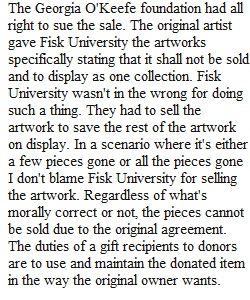


Q Famous artists Georgia O’Keefe and Alfred Stieglitz donated 101 artworks to Fisk University in the 1940s. But the gift had two conditions: The pieces could not be sold and they had to be displayed as one collection. Over 50 years later, Fisk could not pay to maintain the collection and decided to sell two of the pieces. Proceeds of the sale would go to restore its endowment and build a new science building. The Georgia O’Keefe Foundation sued to stop the sale, arguing that the artists would have opposed it. Should the law permit this sale? Do you agree with Fisk’s actions? What duties do gift recipients have to donors? What would Kant and Mill say? You will be awarded 16 points for posting only your discussion and 4 additional points for posting feedback to another student's post. Try and refer to laws we reviewed in class and apply to this situation.
View Related Questions